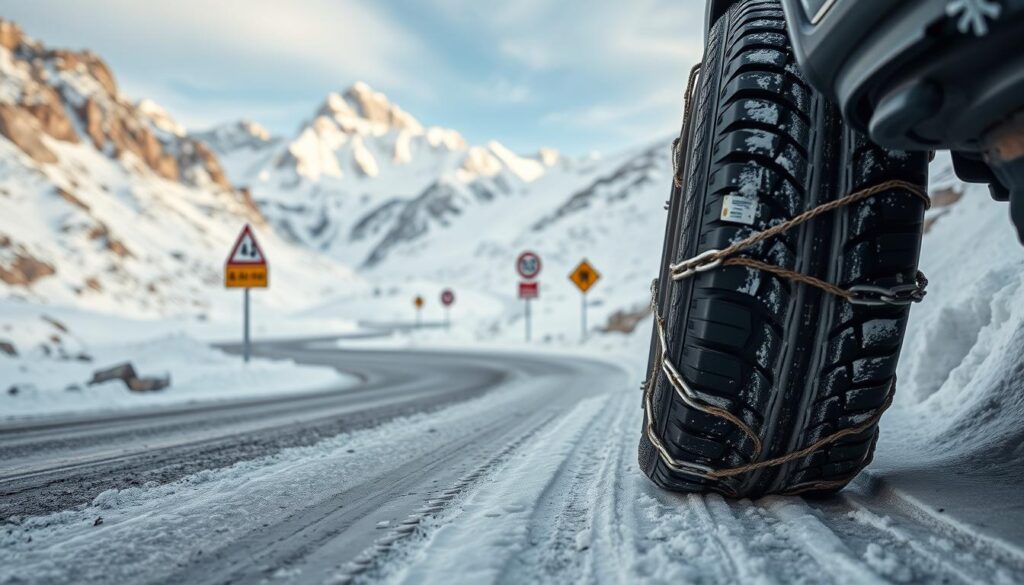Winter Driving Tips to Stay Safe
Did you know that nearly 20% of all vehicle crashes in the U.S. happen during snowy or icy conditions? That statistic highlights a real need for greater awareness behind the wheel when the temperature drops.
As Caltrans notes, a trip through snowy mountains can be a pleasant adventure or a frustrating hazard. It all comes down to your preparation. The cold season brings unique challenges for anyone on the road.
Visibility often drops sharply. Stopping distances become much longer. Road surfaces can change from clear to treacherous in a moment. These factors demand extra vigilance from all drivers.
Whether you’re commuting to work, heading for a ski trip, or visiting family, these conditions affect everyone. It might feel intimidating, but with the right knowledge, you can navigate confidently.
This guide will provide comprehensive advice to keep you secure. We’ll cover everything from getting your vehicle ready to smart techniques for handling slick roads. Your safety is the top priority.
Key Takeaways
- Proper preparation is the key difference between a safe journey and a hazardous one in cold weather.
- Visibility and stopping distances are significantly affected by snowy and icy conditions.
- All motorists, from daily commuters to holiday travelers, need to adapt their habits.
- Feeling prepared builds confidence and reduces the risk of accidents.
- This guide covers essential vehicle checks, emergency kits, and on-road techniques.
Preparation for Winter Driving

Getting your car ready for cold weather is your first line of defense. A well-prepared vehicle handles better and keeps you safer when roads turn slick. This preparation involves two key areas: a thorough mechanical check-up and packing a smart emergency kit.
Vehicle Maintenance and Safety Checks
Start with a professional inspection of your brakes and exhaust system. Cold temperatures can strain your battery and engine, so have them tested. Check antifreeze levels and use a winter-grade oil for better lubrication.
Your tires are critical for traction. Make sure they are properly inflated and have sufficient tread depth. For severe conditions, always carry tire chains that fit your specific wheel size. Know if your vehicle is front or rear wheel drive for correct installation.
Visibility is paramount. Ensure your windshield wipers are effective and your washer fluid is concentrated to resist freezing. A strong defroster and heater are essential for clear windows.
Emergency Kit and Equipment Essentials
Even with a well-maintained car, an emergency kit is a must. Pack an ice scraper, a small shovel, and sand or kitty litter for tire traction if you get stuck. Include a flashlight, warm blankets, extra clothing, water, and non-perishable food.
Keep your gas tank at least half full to prevent fuel-line freeze and ensure you have a reserve. A simple but vital tip: keep an extra car key in your pocket to avoid being locked out during chain installation.
Essential Winter Driving Tips

Your safety on icy roads hinges on two key areas: how you drive and the equipment you use. Mastering both builds the confidence needed for secure travel.
Adjusting Your Behavior on Snow and Ice
A safe highway speed in dry weather becomes risky on slick surfaces. Slowing down is your most important adjustment.
Stopping distances change dramatically. On dry pavement, three seconds may suffice. On snow or ice, allow at least ten seconds between you and the car ahead.
Watch for hidden hazards. Bridge decks and shady spots often freeze first. Anticipate these areas and reduce your speed beforehand.
Avoid sudden stops or sharp turns. These actions can cause a loss of control. Keep your movements smooth and deliberate for better traction.
Proper Use of Winter Tires and Brakes
For optimal grip, experts recommend winter tires on all four wheels. Their special rubber and tread design provide superior performance in the cold.
These tires offer much better contact with the road than all-season options. This gives you more control when you need to brake or turn.
Practice gentle braking. Apply steady, gradual pressure instead of stomping on the pedal. This helps prevent skids on slippery conditions.
Find an empty, snowy lot to safely test your car’s handling. Learn how it responds to starting, stopping, and turning. This practice is invaluable for real-world situations.
Navigating Road Conditions and Chain Controls

Mountain travel during snowy months brings unique challenges that require special preparation and awareness. Understanding how to respond to changing road conditions and chain requirements ensures safer journeys through elevated regions.
Understanding and Installing Chains Correctly
When signs indicate chains are required, you must pull completely off the roadway to install them. You typically have about a mile between warning signs and the checkpoint. Stopping in traffic lanes endangers everyone.
The California Highway Patrol can cite and fine drivers who ignore chain requirements. These rules exist for safety on treacherous roads. Control areas change rapidly due to weather conditions.
| Control Level | Requirement | Speed Limit | Action Required |
|---|---|---|---|
| R1 | Chains on drive wheels | 25-30 mph | Must install chains |
| R2 | Chains or 4WD with snow tires | 25-30 mph | Chains or approved traction |
| R3 | Chains on all vehicles | 25-30 mph | All vehicles must chain up |
Utilizing Caltrans QuickMap and CHIN for Updates
Stay informed with Caltrans’ real-time tools. The QuickMap website shows current traffic conditions, chain controls, and incidents. It helps drivers make smart route decisions.
Call 800-427-7623 for the Highway Information Network. This voice-activated service provides minute-by-minute updates. Pre-load this number before heading to mountain areas.
Weather can change rapidly, requiring route adjustments. Checking conditions before departure prevents surprises. These tools keep you aware of developing situations.
Adapting Your Vehicle and Driving Techniques in Inclement Weather

Mastering control in slick conditions requires a blend of smart vehicle handling and proactive visibility management. These advanced skills build upon your basic preparation, giving you confidence when the weather turns nasty.
Safe Braking Practices and Skid Prevention
Your braking technique needs adjustment on snow or ice. Increase your following distance significantly. It takes much more time and space to come to a complete stop.
If your car begins to skid, stay calm. Keep steady pressure on the brake pedal while focusing on steering. Do not pump the brakes if your vehicle has an anti-lock brake system (ABS).
Modern cars often have Electronic Stability Control (ESC). This system helps prevent skids by applying brakes to individual wheels. If the ESC light flashes, it means the system is actively working to maintain your car’s traction.
Avoid using cruise control in bad weather. These systems can reduce your reaction time and may cause wheel spin on slippery roads.
| Situation | Driver Action | Vehicle System |
|---|---|---|
| Feeling a skid start | Steer smoothly, brake steadily | ESC may activate |
| Poor traction when accelerating | Ease off the gas pedal | Traction control engages |
| Long stopping distance needed | Increase following space | ABS prevents wheel lock-up |
Managing Poor Visibility and Using Defrosters
Clear sightlines are non-negotiable for safety. Before you depart, remove all snow and ice from your windshield, windows, lights, and roof. This prevents hazards for you and other cars.
Use your defroster along with the air conditioner to quickly clear fogged glass. Keep a clean cloth handy to wipe the inside of the windshield if moisture builds up during your trip.
In heavy snow, turn on your headlights to make your vehicle more visible to other drivers. If visibility drops to a dangerous level, find a safe place to pull completely off the road until conditions improve.
Conclusion
Successfully navigating through difficult weather requires a comprehensive approach that combines preparation, awareness, and responsible decision-making. Following these winter driving tips significantly enhances your safety on the road.
Keep your phone fully charged with a charging cable handy for any emergency situation. This simple step ensures you can call for help when needed.
If you get stuck, stay with your vehicle and conserve fuel while maintaining warmth. Be alert to exhaust problems that can occur when vehicles are stationary in snow.
Always allow extra travel time during winter months and plan for challenging conditions. Remember that holiday celebrations often involve alcohol – only drive when completely sober to protect yourself and others.
With proper preparation and these essential strategies, you can confidently handle whatever the winter season brings. Stay safe and travel smart!
FAQ
What’s the most important thing to check on my car before a trip in cold weather?
How can I improve my car’s grip on snowy or icy roads?
What should I do if my car starts to skid on a slippery road?
What items should I keep in my vehicle for an emergency?
How can I get real-time updates on road conditions and chain controls?
How should I adjust my driving when visibility is poor?

Adam Peter is a finance, travel, and automotive writer with over a decade of experience. He creates clear, practical content to help readers manage their money, explore the world with confidence, and make informed decisions about cars and travel gear. His work blends expert insight with real-world usefulness.




